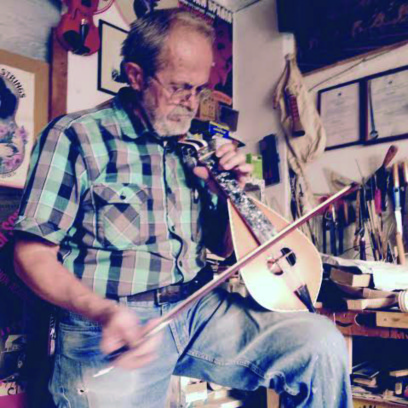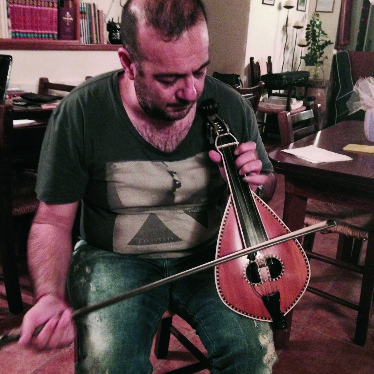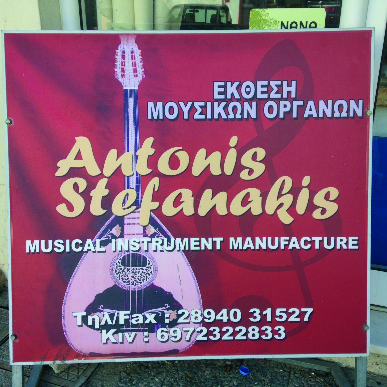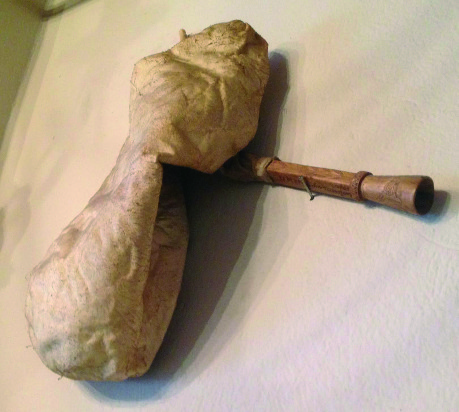The Bagpipe Society
A Serendipitous Stay
Attentive readers will remember that, three years ago, my wife and I went on holiday to Crete, and there, by a stroke of luck, were able to track down the elusive askomandoura: the Cretan tsabouna. This autumn, rain-sodden and worn down by the relentlessly dull summer, we returned.
Crete is a wonderful holiday destination. Arid and mountainous, it has fine weather, even in October. The food is glorious. It’s exotic enough to seem ‘other’ but still European enough for you to feel like you’re on vacation. And Crete’s intense music, born on a Mediterranean crossroads where ancient, Venetian, Byzantine and Ottoman influences have all left their mark, is utterly breathtaking.
Nomi has the knack of finding the perfect holiday let, which is how we ended up staying at Nana Apartments in the village of Zaros. She chose it for its mountain location and reasonable proximity to the sea, without any foreknowledge that our host, Dimitris Stefanakis, had been a child prodigy on the lira, and that his father, Antonis, was one of Crete’s most respected luthiers. Amongst other things, Antonis makes askomandoura! Effortlessly, she’d taken us to the perfect place.

We did, of course, do the usual holiday things. We went to the stunning archaeological museum in Heraklion; we clambered halfway up Zaros gorge, with Minka strapped to Nomi’s back; we explored an ancient oak forest, high in the mountains; and we went repeatedly to the beach to ramp up our vitamin D. But we also spent a lot of time talking to Antonis, who explained some of the finer points of Cretan music. One evening he played the lira for us, and I watched, as spellbound as a child.
The lira is the principle instrument of Cretan music. Bowed, with a pear- shaped body and just three strings, it is most commonly thought of as a kind of upright fiddle, though I suspect, as its name suggests, its origins are actually as a bowed lyre. The strings aren’t stopped down onto a finger board, but touched with the backs of the finger nails. I had a go and can confirm that it’s extremely difficult, but the technique allows you to slide your fingers up and down the strings and so produce the ornaments that give Cretan music its distinctive flavour. Those tiny ornaments are called morio, or ‘molecules’.

In the hands of an expert, the lira is exquisitely expressive, conveying that haunting mix of beauty, longing, joy and sadness that is so often the hallmark of traditional music. However, its traditional function is to play for dancing, accompanied by the
metronomic chords of the lauto, the Cretan long-necked lute. Dimitris explained how at say, a wedding, or a Panigiri (a festival), musicians are expected to play all night, from nine or ten o’clock in the evening, through to eight in the morning. It’s their job to sense the mood of the dancers and to play appropriately. If the mood is getting a bit somber then they have to liven things up again. If the raki is causing a bit of argy-bargy, then they have to play something jolly in a major key. I couldn’t help thinking of Plato, cautioning us to the power of the modes to affect behaviour.
Interestingly the lira often imitates the sound of the askomandoura, suggesting that the bagpipe, which was originally a shepherd’s instrument, once took a more prominent role in Cretan music. It is on the ascendancy again, having nearly gone extinct. In 2004, when Lucy Duran made her World Routes programme for Radio 3, about the music of Crete, she found, and recorded, what she believed to be one of the last living askomandoura players, a shepherd dwelling high up in the mountains. Perhaps the sound was too raw, the five note range too limited, or the instrument too associated with shepherds and the past, but back in 2004 he could find no one interested in taking up the instrument.
Nevertheless, nostalgia for the askomandoura was somehow kept alive, not least by a recording of Cretan songs, Ta Pou Thimoume Tragoudo, released in 1975 by Crete’s most famous singer, Nikos Xylouris. The album opens with the song, Anogianes Kodilies, which prominently features askomandoura. The song is now a standard amongst a new generation of askomandoura players who are defying expectation by reviving the instrument.
I’m not sure what prompted the revival, but it seems to be centred around the mountain village of Gergeri (next door to Zaros). Three years ago I couldn’t find a recording of askomandoura music in the CD shops. This time I picked up an album, Ontas - Musical Breath, by a young hotshot player, Giorgis Saloustros. That Psarantonis, Nikos Xylouris’ equally famous brother, guests on the album, suggests that the bagpipe is once again taking its rightful place in Cretan music.

Like tsabouna music everywhere, the askomandoura style revolves around so-called parataxis: improvisation based upon a
repertoire of rhythmic ’loops’ that are mixed up as the player chooses. What seems to distinguish askomandoura music from that of the tsabouna more generally, is that the tonal centre moves. Musical cues, offered by the piper, tell the accompanying lauto player to shift chords, not unlike Miles Davies’ modal jazz. It gives the music a feeling of constant movement, of tension and release, and Saloustris has mastered it with breathtaking effect.
Back in Zaros, we went to visit Antonis’s workshop. Now in his seventies, he was once more famous as a dancer than a maker of instruments. In his youth he travelled the world, performing Cretan dance at international festivals. It is said that he could leap to shoulder height from standing, and that his party trick was to vault right out of a taverna window, only to carry on dancing where he landed. I have no doubt that the stories are true for there’s a photo of him on the wall of the workshop, standing one-footed on a beer glass, balanced on a beer bottle on a table. He learnt his craft as a luthier from a guitar- maker in Germany, where he was working as a truck driver, and really his forte is making liras and lutes. Perhaps that’s why he didn’t have a working set of bagpipes to hand, though he willingly demonstrated the mouth-blown reedpipe called the mandoura. (In fact, mandoura means ‘reed pipe’, and asko, ‘bag’, so the askomandoura is simply the bagged reedpipe.) I was surprised at how soft and muted it sounded. Clearly something rather magic happens when you play two reedpipes together and you get the classic tsabouna ‘grind’.

Sadly, our week on Crete disappeared all too quickly and we had to head home. It’s easy to get carried away on holiday, and especially so in Crete where the presence of the past is everywhere close at hand: from the Palace of Knossos to the cave where Zeus was born. But if the gods lead you straight to a man who can make you a set of askomandoura, what are you to do? Surely it would have been churlish not to order a set, don’t you think? I’m expecting them to arrive anytime soon so I’ll let you know how I get on.
You can find Nana Apartments at: http://www.nana-apartments.gr. Antonis Stefanakis has his website here: http://www.stefanakis-antonis.gr Watch him play the mandoura, together with a young Dimitris on lira, here: http://tinyurl.com/hsp2grz
Listen to the World Routes programme about Crete here: http://www.bbc.co.uk/programmes/p005xk9t
Buy Ontas - Musical Breaths here: http://tinyurl.com/h67bb2f
Read more about parataxis here: http://tinyurl.com/hyrx5ns
- Data Processing Notice (GDPR)
-
@BagpipeSociety on X (formally known as Twitter)
-
TheBagpipeSociety on Instagram
-
 BagpipeSociety on Facebook
BagpipeSociety on Facebook
Something wrong or missing from this page? Let us know!
